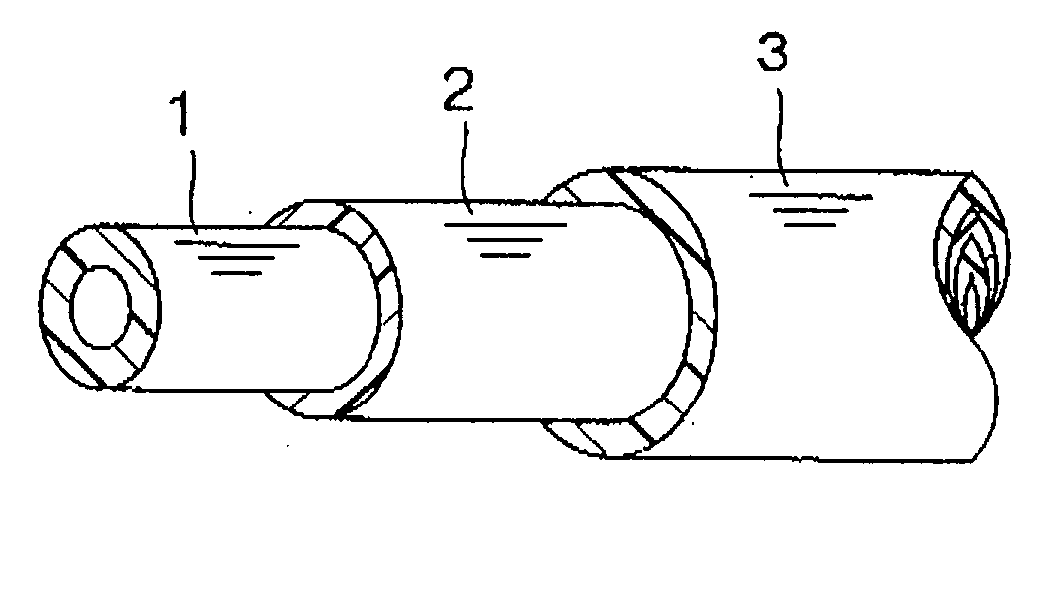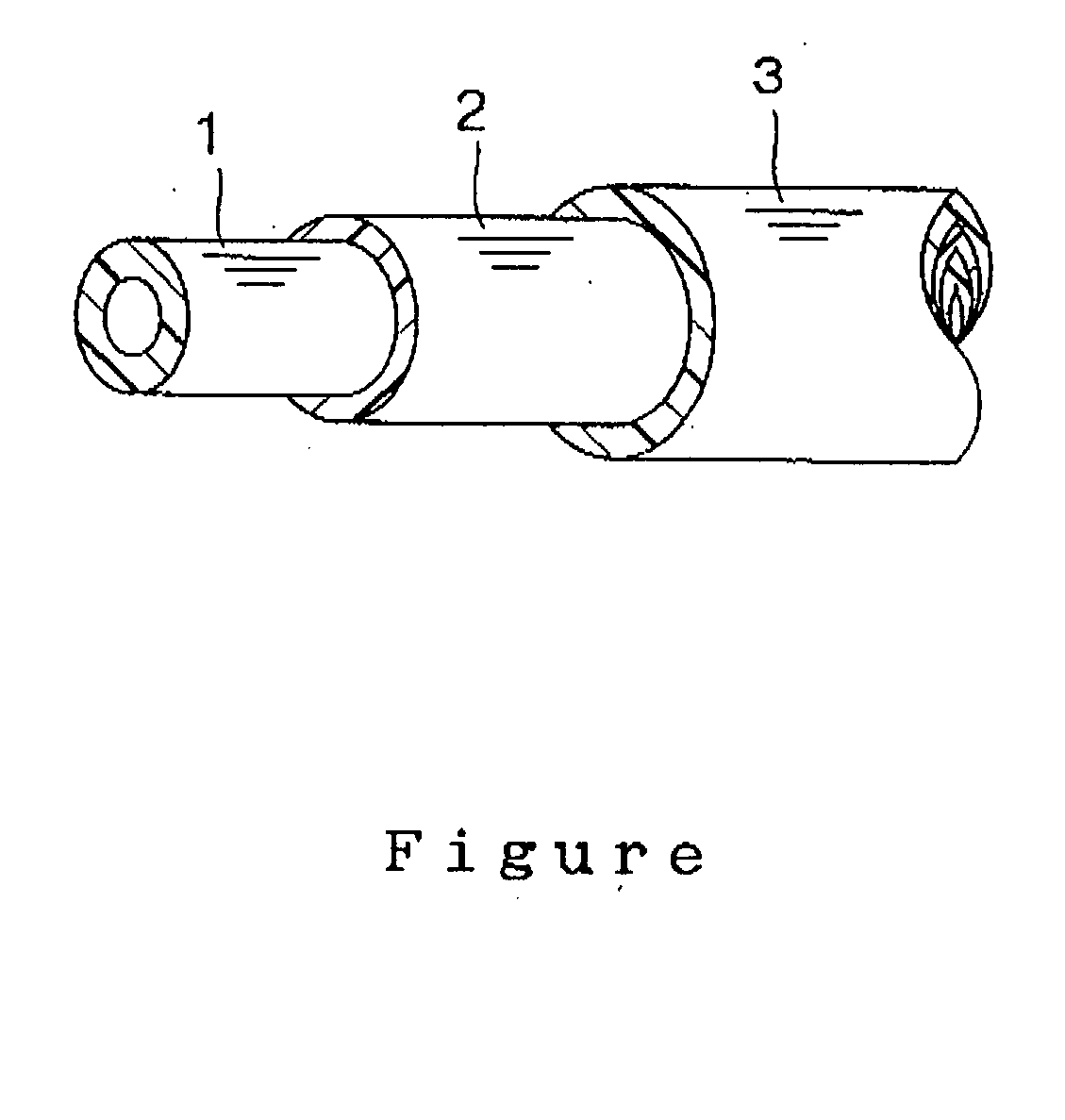Fuel hose
- Summary
- Abstract
- Description
- Claims
- Application Information
AI Technical Summary
Benefits of technology
Problems solved by technology
Method used
Image
Examples
example 1
[0047] [Preparation of Innermost Layer]
[0048] A material for an innermost layer was prepared by kneading 40 parts of ACM (DENKA ER-3400, available from DENKI KAGAKU KOGYO KABUSHIKI KAISHA), 60 parts of NBR (Nipol DN202 available from Zeon Corporation, bound acrylonitrile amount: 31 wt %), 50 parts of carbon black (SEAST 116, available from Tokai Carbon, Co., Ltd.), 1 part of a DBU salt (DA-500, available from Daiso Co., Ltd.), 1 part of a processing aid (LUNAC S-30, available from KAO Corporation), 20 parts of silica (Carplex 1120, available from SHIONOGI & CO., LTD.), 10 parts of a plasticizer (ADECASIZER RS-107, available from Asahi Denka Co., Ltd.), 2 parts of a vulcanizing agent (CN-25, available from DENKI KAGAKU KOGYO KABUSHIKI KAISHA), 0.5 parts of sulfur and 0.3 parts of a vulcanization accelerator aid (VULNOCAB-S, available from Ouchi Shinko Chemical Industrial Co., Ltd.) by means of a kneader. Thus obtained polymer rubber as a material for the innermost layer contained acr...
example 2
[0055] A material for an innermost layer was prepared by kneading 30 parts of ACM (DENKA ER-3400, available from DENKI KAGAKU KOGYO KABUSHIKI KAISHA), 70 parts of NBR (Nipol DN101, available from Zeon Corporation, bound acrylonitrile amount: 42.5wt %), 50 parts of carbon black (SEAST 116, available from Tokai Carbon, Co., Ltd.), 1 part of DBU salt (DA-500, available from Daiso Co., Ltd.), 1 part of processing aid (LUNAC S-30, available from KAO Corporation), 20parts of silica (Carplex 1120, available from SHIONOGI & CO., LTD.), 10 parts of a plasticizer (ADECASIZERRS-107, available from Asahi Denka Co., Ltd.), 2 parts of a vulcanizing agent (CN-25, available from DENKI KAGAKU KOGYO KABUSHIKI KAISHA), 0.5 parts of sulfur and 0.3 parts of a vulcanization accelerator aid (VULNOC AB-S, available from Ouchi Shinko Chemical Industrial Co., Ltd.) by means of a kneader. The thus obtained polymer rubber as a material for the innermost layer contained acrylonitrile at 29.8 wt %. Except for th...
example 3
[0056] A material for an innermost layer was prepared by kneading 70 parts of ACM (DENKA ER-3400, available from DENKI KAGAKU KOGYO KABUSHIKI KAISHA), 30 parts of NBR (Nipol DN009, available from Zeon Corporation, bound acrylonitrile amount: 50 wt %), 50 parts of carbon black (SEAST 116, available from Tokai Carbon, Co., Ltd.), 1 part of a DBU salt (DA-500, available from Daiso Co., Ltd.), 1 part of a processing aid (LUNAC S-30, available from KAO Corporation), 20 parts of silica (Carplex 1120, available from SHIONOGI & CO., LTD.), 10 parts of a plasticizer (ADECASIZER RS-107, available from Asahi Denka Co., Ltd.), 2 parts of a vulcanizing agent (CN-25, available from, DENKI KAGAKU KOGYO KABUSHIKI KAISHA), 0.5 parts of sulfur and 0.3 parts of a vulcanization accelerator aid (VULNOCAB-S, available from Ouchi Shinko Chemical Industrial Co., Ltd.) by means of a kneader. The thus obtained polymer rubber as a material for the innermost layer contained acrylonitrile at 15 wt %. Except for...
PUM
| Property | Measurement | Unit |
|---|---|---|
| Temperature | aaaaa | aaaaa |
| Electrical conductivity | aaaaa | aaaaa |
| Electrical resistance | aaaaa | aaaaa |
Abstract
Description
Claims
Application Information
 Login to View More
Login to View More - R&D
- Intellectual Property
- Life Sciences
- Materials
- Tech Scout
- Unparalleled Data Quality
- Higher Quality Content
- 60% Fewer Hallucinations
Browse by: Latest US Patents, China's latest patents, Technical Efficacy Thesaurus, Application Domain, Technology Topic, Popular Technical Reports.
© 2025 PatSnap. All rights reserved.Legal|Privacy policy|Modern Slavery Act Transparency Statement|Sitemap|About US| Contact US: help@patsnap.com


